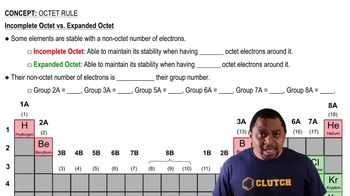A series of anions is shown below: The anion on the far right is called 'BARF' by chemists, as its common abbreviation sounds similar to this word. (c) Which, if any, of these anions has an expanded octet around its central atom?
 Verified step by step guidance
Verified step by step guidance
Verified video answer for a similar problem:
Key Concepts
Expanded Octet

Central Atom in Anions

Lewis Structures

A series of anions is shown below:
The anion on the far right is called 'BARF' by chemists, as its common abbreviation sounds similar to this word. (a) What is the central atom and the number of electronpair domains around the central atom in each of these anions?
A series of anions is shown below:
The anion on the far right is called 'BARF' by chemists, as its common abbreviation sounds similar to this word. (b) What is the electron-domain geometry around the central B in BARF?
Compounds like sodium stearate, called 'surfactants' in general, can form structures known as micelles in water, once the solution concentration reaches the value known as the critical micelle concentration (cmc). Micelles contain dozens to hundreds of molecules. The cmc depends on the substance, the solvent, and the temperature. (a) The turbidity (the amount of light scattering) of solutions increases dramatically at the cmc. Suggest an explanation. .
